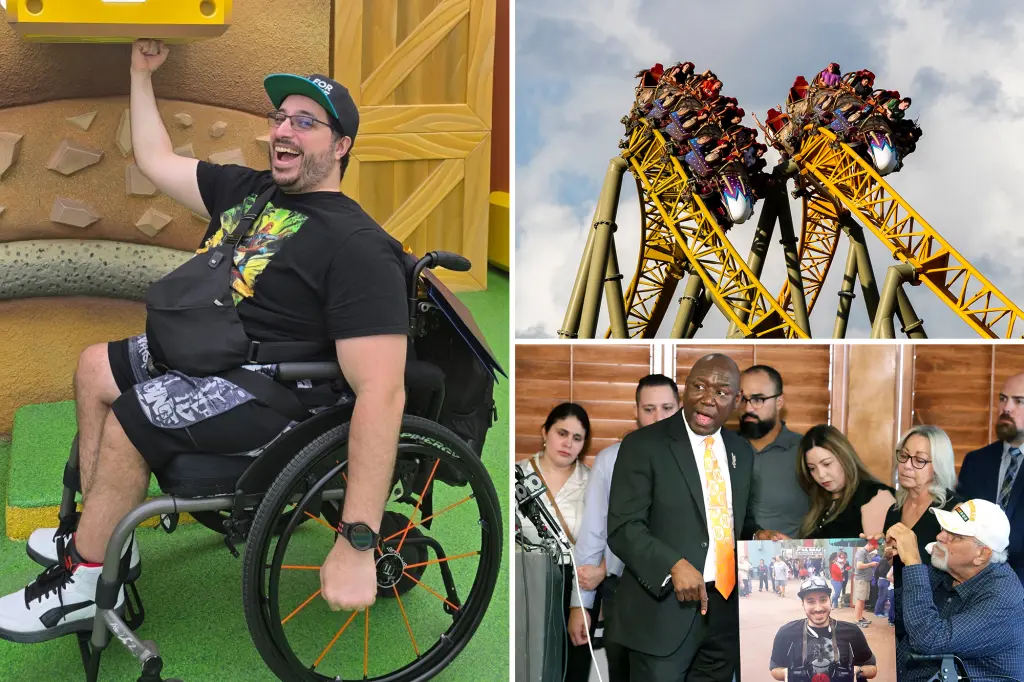The Tragic Death at Epic Universe: A Family’s Fight for Answers and Accountability
In a heartbreaking case that has drawn national attention, the family of Kevin Rodriguez Zavala is seeking answers following his death on the Stardust Racers rollercoaster at Universal Orlando’s Epic Universe. The 32-year-old wheelchair user died on September 17th while riding the popular attraction, leaving his loved ones devastated and raising serious questions about ride safety protocols. According to attorney Ben Crump, who is representing the family, they have now heard from “multiple” other riders who claim to have suffered injuries on the same rollercoaster. This pattern suggests that Zavala’s death may not have been an isolated incident but potentially part of a troubling series of overlooked safety concerns. The family alleges that Universal Orlando missed “multiple warning signs” that could have prevented this tragedy, casting a shadow over the park’s commitment to guest safety and emergency preparedness.
The details surrounding Zavala’s final moments are deeply disturbing. The 32-year-old, who had spinal cord atrophy and used a wheelchair in daily life, suffered fatal blunt impact injuries during what should have been an exciting experience with his girlfriend. Crump’s investigative team has determined that Zavala “suffered repeated head injuries during the ride and was unconscious for the majority of the duration of the ride,” according to Natalie Jackson, co-director of litigation for Crump’s Central Florida office. He also sustained lacerations during the ride. Multiple eyewitnesses described a horrific scene, with Zavala slumped over in the front seat, blood visible throughout the area. Adding to the family’s grief is their claim that park employees seemed unprepared to handle the emergency situation that unfolded, raising questions about staff training and emergency protocols at one of America’s premier theme parks.
The family’s concerns have been amplified by reports from other guests who claim to have experienced similar issues on the Stardust Racers attraction. Among these accounts is one from a woman who allegedly was injured in May, months before Zavala’s death. She claims to have lost consciousness, suffered a concussion, and sustained spine injuries while riding the same coaster. This revelation has been particularly troubling for Zavala’s family, who see it as evidence that the park may have known about potential dangers but failed to take appropriate action. According to Crump, Universal has self-reported four incidents regarding Stardust Racers, but in each case, they concluded the injuries were caused by “pre-existing conditions” rather than issues with the ride itself. This pattern of attribution has raised suspicions among the family and their legal team about whether the park has been truly transparent about safety concerns.
Adding to the controversy is the family’s claim that Universal has denied multiple requests to provide video footage of the incident. This perceived lack of transparency has only deepened their suspicions and fueled their determination to seek accountability. The Stardust Racers is not a mild attraction – it’s a dual-launch coaster that propels riders along the track at speeds up to 62 miles per hour and reaches heights of 133 feet. For someone with Zavala’s physical condition, these forces could potentially create significant risks, raising questions about the adequacy of safety warnings, rider restrictions, and whether the attraction should have additional accommodations or limitations for guests with certain medical conditions. The high-speed, high-intensity nature of the ride means that any safety oversight could have devastating consequences, as tragically demonstrated in this case.
In stark contrast to the family’s allegations, Karen Irwin, President and COO of Universal Orlando Resort, has maintained in an internal memo that the ride was functioning normally during the incident. According to this communication, all equipment was intact and staff were “following procedures” when the tragedy occurred. This position sets up a significant disparity between the narrative presented by Universal executives and the experiences described by Zavala’s family and the other riders who have come forward. The divergence in these accounts highlights the challenges in determining accountability in amusement park accidents, where complex mechanical systems, human factors, and pre-existing medical conditions can all potentially contribute to tragic outcomes. For Zavala’s family, however, the central question remains whether enough was done to ensure the safety of all guests, particularly those with physical conditions that might make them more vulnerable to the intense forces experienced on such attractions.
The tragedy of Kevin Rodriguez Zavala extends beyond just one family’s loss. It touches on broader concerns about accessibility, safety, and transparency in the theme park industry. For millions of visitors with disabilities or medical conditions who seek the joy and thrill of these attractions, stories like Zavala’s raise uncomfortable questions about whether their safety is being adequately considered. As the investigation continues and more witnesses potentially come forward, the spotlight will remain on Universal Orlando’s safety protocols, emergency response procedures, and communication transparency. For Zavala’s family, no resolution can bring back their loved one, but their pursuit of answers may help prevent similar tragedies in the future. Through their grief, they have become reluctant advocates for enhanced safety measures that could protect other vulnerable guests from experiencing the same devastating outcome. As they continue to seek justice for Kevin, their story serves as a sobering reminder of the responsibilities that come with operating attractions that millions trust with their lives each year.


